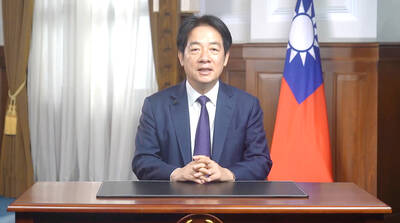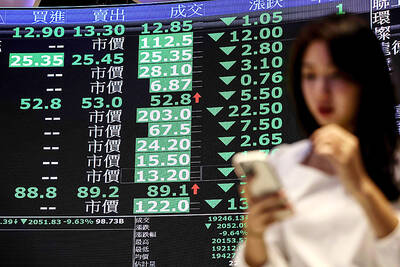The term “1992 consensus” was non-existent until 2000, when then-Mainland Affairs Commission chairman Su Chi (蘇起) first used it, American Institute in Taiwan (AIT) Chairman Raymond Burghardt said.
Burghardt made the remarks in an interview with Voice of America in Washington on Wednesday when he was asked about the historical background of the so-called “1992 consensus,” as he was formerly the US consul-general in Shanghai.
“I think everyone in China knows, the term ‘1992 consensus’ was not used by anyone until 2001, no, 2000; Su Chi, [former] president Ma Jing-jeou’s [馬英九] first National Security Council adviser, was the first person to use that term to describe the understanding that had been reached in 1992. Before that, I mean, in all the time I met with [then-Association for Relations Across the Taiwan Straits (ARATS) chairman] Wang Daohan (汪道涵) or with [then-Straits Exchange Foundation (SEF) chairman] Koo Chen-fu (辜振甫), they never called it that, never called it the ‘1992 consensus,’ because the name didn’t exist. Koo would sometimes just call it the ‘1992 understanding,’” he said.

Photo provided by Taipei Photojournalists Association
The “1992 consensus” refers to a tacit understanding between the two sides of the Taiwan Strait that there is “one China,” with each side having its own interpretation of what “China” means.
In 2006, Su, then a Chinese Nationalist Party (KMT) legislator, admitted he made up the term “1992 consensus” in 2000, before the KMT handed power to the Democratic Progressive Party.
Meanwhile, responding to the question of whether President Tsai Ing-wen (蔡英文) was muddying the water when she did not explicitly recognize or deny the “1992 consensus” or the “one China” principle in her inauguration address, Burghardt said Tsai has displayed flexibility in dealing with cross-strait relations and it is important for both China and Taiwan to continue to communicate.
He also said it is important for both sides to “create a certain amount of ambiguity,” adding that there was a lot of ambiguity in the understanding reached between the Ma administration and China.
Burghardt said this is an important period for both Beijing and Taipei to carefully watch each other’s actions and statements.
However, he also said it is very important for both sides to “keep an open mind” and maintain communication.
Burghardt said that one of the things the US prized very much after Ma took office in May 2008 was the “restoration of regular communication across the Strait.”
He said that if both sides can talk to each other, miscommunication, misunderstanding and miscalculation “can all be avoided.”
Asked whether cross-strait relations are not as warm as during the Ma administration, Burghardt said that “it is unfortunate that Beijing decided to discontinue or suspend talks” between the two sides recently.
He expressed hope that Beijing can understand the importance of cross-strait communication and will want to continue, as “nothing is going to be fixed without continued communication.”

ACTION PLAN: Taiwan would expand procurement from the US and encourage more companies to invest in the US to deepen bilateral cooperation, Lai said The government would not impose reciprocal tariffs in retaliation against US levies, President William Lai (賴清德) said yesterday, as he announced five strategies to address the issue, including pledging to increase Taiwanese companies’ investments in the US. Lai has in the past few days met with administrative and national security officials, as well as representatives from various industries, to explore countermeasures after US President Donald Trump on Wednesday last week announced a 32 percent duty on Taiwanese imports. In a video released yesterday evening, Lai said that Taiwan would not retaliate against the US with higher tariffs and Taiwanese companies’ commitments to

Intelligence agents have recorded 510,000 instances of “controversial information” being spread online by the Chinese Communist Party (CCP) so far this year, the National Security Bureau (NSB) said in a report yesterday, as it warned of artificial intelligence (AI) being employed to generate destabilizing misinformation. The bureau submitted a written report to the Legislative Yuan in preparation for National Security Bureau Director-General Tsai Ming-yen’s (蔡明彥) appearance before the Foreign Affairs and National Defense Committee today. The CCP has been using cognitive warfare to divide Taiwanese society by commenting on controversial issues such as Taiwan Semiconductor Manufacturing Co’s (TSMC, 台積電) investments in the

HELPING HAND: The steering committee of the National Stabilization Fund is expected to hold a meeting to discuss how and when to utilize the fund to help buffer the sell-off The TAIEX plunged 2,065.87 points, or 9.7 percent, to close at 19,232.35 yesterday, the highest single-day percentage loss on record, as investors braced for US President Donald Trump’s tariffs after an extended holiday weekend. Amid the pessimistic atmosphere, 945 listed companies led by large-cap stocks — including Taiwan Semiconductor Manufacturing Co (TSMC, 台積電), Hon Hai Precision Industry Co (鴻海精密) and Largan Precision Co (大立光) — fell by the daily maximum of 10 percent at the close, Taiwan Stock Exchange data showed. The number of listed companies ending limit-down set a new record, the exchange said. The TAIEX plunged by daily maxiumu in just

‘COMPREHENSIVE PLAN’: Lin Chia-lung said that the government was ready to talk about a variety of issues, including investment in and purchases from the US The National Stabilization Fund (NSF) yesterday announced that it would step in to staunch stock market losses for the ninth time in the nation’s history. An NSF board meeting, originally scheduled for Monday next week, was moved to yesterday after stocks plummeted in the wake of US President Donald Trump’s announcement of 32 percent tariffs on Taiwan on Wednesday last week. Board members voted to support the stock market with the NT$500 billion (US$15.15 billion) fund, with injections of funds to begin as soon as today. The NSF in 2000 injected NT$120 billion to stabilize stocks, the most ever. The lowest amount it